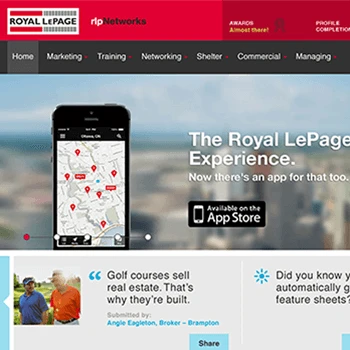How does Experience Thinking apply to real estate and construction digital solutions?
Our Experience Thinking framework addresses four connected areas: how people experience your brand, content, products, and services. In real estate and construction, this means ensuring your brand feels professional and trustworthy, your content helps clients understand complex processes, your digital tools solve real workflow problems, and your services support customers through major life decisions like home purchases or construction projects. Each area strengthens the others to create seamless experiences that build lasting business relationships.
Tip: Start with mapping your current customer journey from first contact through project completion to identify where each Experience Thinking area can reduce friction and build trust.
What makes real estate and construction UX different from other industries?
These industries involve high-stakes decisions, large financial commitments, and complex multi-party transactions. Customers often work with agents or contractors only occasionally, so interfaces must be intuitive for infrequent users. Projects involve multiple stakeholders with different technical knowledge levels, from homeowners to contractors to inspectors. Additionally, many workflows still rely on traditional paper-based processes that need thoughtful digitization.
Tip: Design for the least tech-savvy user in your workflow while providing progressive disclosure for power users who need advanced functionality.
How do you understand the specific needs of real estate agents versus construction professionals?
Real estate agents focus on lead generation, client relationship management, property marketing, and transaction coordination. Construction professionals need project management, resource scheduling, safety compliance, and field data collection. Both groups work in fast-paced environments with tight deadlines, but real estate operates on shorter sales cycles while construction involves longer project timelines with more complex coordination requirements.
Tip: Conduct separate research sessions with agents and construction professionals rather than combining them, as their daily workflows and pain points are quite different.
What's your approach to balancing industry regulations with user experience?
Real estate and construction have specific legal requirements for disclosures, documentation, and compliance reporting. We work with legal and regulatory specialists to understand mandatory processes, then design experiences where compliance supports rather than hinders productivity. The goal is embedding required documentation and approvals naturally into workflows rather than treating them as separate administrative tasks.
Tip: Create a regulatory requirements matrix early in your project to identify which compliance elements can be automated or integrated into natural task flows.
How do you help us define UX strategy for traditional industries embracing digital transformation?
We start by understanding current workflows and identifying the biggest pain points that digital solutions can address. Rather than digitizing everything at once, we prioritize high-impact areas where technology can immediately improve efficiency or customer satisfaction. The strategy considers change management and training needs since users may be less comfortable with digital tools.
Tip: Begin digital transformation with tools that solve obvious pain points rather than trying to revolutionize entire workflows in the first phase.
What role does trust play in real estate and construction UX design?
Trust is fundamental when people are making major financial decisions or managing complex projects. Professional-looking interfaces, clear communication, and transparent processes all contribute to trustworthiness. Visual design, data security messaging, and error handling significantly impact whether clients feel confident in your expertise and reliability.
Tip: Include client testimonials, professional credentials, and project portfolios prominently in your interface design to reinforce credibility and competence.
How do you approach UX strategy for both client-facing and internal operational tools?
Client-facing tools focus on clear communication, progress transparency, and easy interaction with non-experts. Internal tools prioritize efficiency, data accuracy, and workflow optimization for daily use by professionals. Both require different design approaches but should share consistent branding and data integration to create seamless handoffs between client and internal interactions.
Tip: Map data flow between client-facing and internal tools early to ensure information captured from clients automatically populates internal systems without manual re-entry.
What research methods work best for understanding real estate agent workflows?
We use contextual inquiry to observe agents during actual client interactions, diary studies to capture how technology fits into daily routines, and journey mapping to understand the complete sales process from lead to closing. Interviews with both agents and their clients reveal different perspectives on the same interactions, helping us design solutions that work for both sides.
Tip: Shadow agents during different types of client meetings (listings, showings, closings) to understand how technology needs vary across different phases of the sales process.
How do you conduct research with construction teams in active work environments?
Construction research requires careful coordination with site safety protocols and project schedules. We use mobile research methods, brief field observations during appropriate times, and post-shift interviews to minimize disruption. Photo and video documentation helps capture context while respecting safety requirements and proprietary information concerns.
Tip: Partner with project managers to identify the safest times and locations for research activities, and always prioritize safety protocols over research convenience.
What's your approach to researching multi-stakeholder transactions like home purchases?
Home purchases involve buyers, sellers, agents, lenders, inspectors, and legal professionals. We research each stakeholder's role, information needs, and interaction points to understand the complete ecosystem. This reveals where communication breakdowns occur and identifies opportunities for digital tools to improve coordination and transparency across all parties.
Tip: Create stakeholder maps that show information flow and decision dependencies to identify where UX improvements can have the biggest impact on transaction success.
How do you research technology adoption barriers in traditional industries?
We explore current technology comfort levels, past experiences with digital tools, and specific concerns about adopting new systems. Research includes understanding training time constraints, resistance to change, and workflow disruption fears. This helps us design adoption strategies that address real concerns rather than assuming resistance is simply about age or experience.
Tip: Include questions about successful technology adoptions in other areas of participants' lives to understand what makes them comfortable with new digital tools.
What's your approach to researching seasonal and cyclical business patterns?
Real estate and construction have busy seasons, weather dependencies, and market cycles that affect how people work. We time research to capture both peak and slow periods, understanding how tool needs change throughout different business cycles. This ensures solutions work well during high-stress busy times and support business development during slower periods.
Tip: Plan research activities across different seasons to understand how weather, market conditions, and business cycles affect technology usage patterns.
How do you validate research findings with industry-specific metrics?
We use industry-relevant success measures like time-to-close for real estate transactions, project completion rates for construction, client satisfaction scores, and efficiency improvements in key workflows. Research validation includes testing whether proposed solutions actually improve these specific business outcomes rather than just general usability measures.
Tip: Establish baseline measurements for key business processes before implementing UX changes so you can demonstrate actual impact on industry-specific performance indicators.
What's your approach to researching compliance and safety requirements?
We work with regulatory specialists and safety officers to understand mandatory requirements, then research how these requirements currently impact workflows. This includes understanding the cost of non-compliance, time spent on documentation, and how safety or regulatory concerns affect technology adoption decisions.
Tip: Include compliance officers and safety managers in your research participant recruitment to understand regulatory constraints from the expert perspective.
How do you design mobile-first solutions for field work and property showings?
Through our Experience Thinking product quadrant approach, we prioritize core tasks that happen in the field and design for one-handed operation, varying lighting conditions, and unreliable internet connections. Mobile interfaces focus on data capture, communication, and quick access to essential information while ensuring offline functionality for remote construction sites or areas with poor cell coverage.
Tip: Test mobile interfaces in actual field conditions with gloves, hard hats, and varying weather to ensure designs work in real-world professional environments.
What's your approach to designing dashboard experiences for project management?
Project management dashboards must present complex information in scannable formats that support quick decision-making. We design information hierarchies that highlight urgent items, progress indicators that show project health at a glance, and customizable views for different roles (project managers, subcontractors, clients). The goal is reducing information overload while ensuring critical details are accessible.
Tip: Design role-based dashboard views that automatically filter information to what each user type needs to see rather than showing everything to everyone.
How do you design client communication interfaces that build confidence?
Client-facing interfaces focus on clear progress communication, transparent pricing, and easy access to project documentation. We design automated update systems that keep clients informed without overwhelming them, visual progress indicators that make complex projects understandable, and secure document sharing that maintains professional credibility.
Tip: Include proactive communication triggers that automatically notify clients of important milestones or changes rather than waiting for them to check in.
What's your approach to designing document management systems for complex transactions?
Real estate and construction generate enormous amounts of documentation with specific organization and retention requirements. We design systems that automatically categorize documents, provide version control, and enable quick retrieval during time-sensitive transactions. The interface supports both systematic filing and rapid search for urgent document needs.
Tip: Design document systems with automatic metadata capture and AI-powered categorization to reduce manual filing time while ensuring documents remain findable.
How do you design accessible interfaces for users with varying technical skills?
We design progressive disclosure that lets beginners access basic functionality immediately while providing advanced features for power users. Visual design uses familiar metaphors from traditional workflows, clear labeling, and help systems that provide just-in-time guidance. The goal is reducing the learning curve without limiting functionality for experienced users.
Tip: Create user onboarding flows that adapt to each person's comfort level with technology rather than using one-size-fits-all training approaches.
What's your approach to designing scheduling and resource management interfaces?
Scheduling interfaces must handle complex dependencies, resource conflicts, and last-minute changes common in both real estate and construction. We design visual scheduling systems that make conflicts obvious, automated notification systems for schedule changes, and resource allocation views that prevent double-booking of equipment or personnel.
Tip: Include weather integration and seasonal considerations in scheduling interfaces since outdoor work and property showings are weather-dependent.
How do you design safety and compliance tracking interfaces?
Using our Experience Thinking service quadrant principles, safety interfaces integrate compliance checking into natural workflows rather than treating it as separate administrative tasks. We design systems that capture safety data efficiently, provide real-time compliance status, and alert users to potential violations before they occur. The interface supports both individual compliance and project-wide safety management.
Tip: Design safety interfaces that work well with personal protective equipment, including voice activation or large touch targets that work with work gloves.
How do you support implementation in organizations with limited IT resources?
We provide implementation support that includes training non-technical staff, creating documentation that speaks to business needs rather than technical specifications, and establishing processes for ongoing system maintenance. Our approach recognizes that smaller real estate and construction companies often lack dedicated IT departments.
Tip: Identify your most tech-savvy employees early and train them as internal champions who can provide ongoing support to their colleagues.
What's your approach to change management in traditional industries?
Change management focuses on demonstrating immediate value rather than requiring faith in long-term benefits. We recommend pilot implementations with willing early adopters, clear measurement of efficiency gains, and gradual rollout that allows time for adaptation. Training emphasizes how new tools solve existing frustrations rather than requiring completely new workflows.
Tip: Start implementation with your most enthusiastic users and use their success stories to encourage adoption among more skeptical team members.
How do you measure UX success in real estate and construction applications?
Success metrics combine usability measures with industry-specific outcomes like reduced transaction time, improved client satisfaction scores, decreased error rates in documentation, and increased project completion rates. We establish baseline measurements before implementation and track improvements in both user experience and business performance over time.
Tip: Track both efficiency metrics (time saved, errors reduced) and relationship metrics (client satisfaction, repeat business) since both are crucial for long-term business success.
What's your approach to training users who may be resistant to new technology?
Training programs emphasize practical benefits and connect new digital tools to familiar processes. We use peer training approaches where tech-comfortable colleagues mentor others, provide multiple learning formats (visual, hands-on, reference materials), and ensure training happens in manageable chunks that don't overwhelm busy professionals.
Tip: Schedule training during slower business periods and provide ongoing support resources rather than expecting people to learn everything in initial training sessions.
How do you handle data migration from legacy systems or paper processes?
Data migration planning considers both technical transfer and user adaptation to new data organization methods. We help design migration strategies that maintain business continuity, provide data validation processes to ensure accuracy, and create bridge solutions that allow gradual transition from old to new systems without disrupting ongoing projects.
Tip: Plan data migration in phases that align with natural business cycles (between projects, during slow seasons) to minimize disruption to active client work.
What's your approach to ongoing optimization after initial implementation?
We establish monitoring systems that track both technical performance and user behavior patterns. Regular check-ins with users help identify new efficiency opportunities as they become comfortable with basic functionality. Optimization focuses on adding advanced features that build on successful adoption rather than changing core workflows users have learned.
Tip: Set up quarterly review sessions with power users to identify workflow improvements and new feature opportunities based on actual usage patterns.
How do you ensure solutions scale as businesses grow?
Scalability planning considers both technical architecture and user management as teams grow. We design permission systems that support organizational hierarchy, data organization that handles increasing project volumes, and workflow automation that reduces administrative overhead as businesses expand. The goal is supporting growth without proportional increases in complexity.
Tip: Design user management and data organization systems that can accommodate at least 3x your current size to avoid requiring system overhauls during growth phases.
How would you design lead management systems that convert prospects into clients?
Lead management design focuses on quick response capabilities, automated follow-up systems, and client preference tracking that personalizes interactions. We design systems that capture lead sources, track communication history, and provide prompts for timely follow-up actions. The interface supports both high-volume lead processing and personalized relationship building.
Tip: Include lead scoring and prioritization features that help agents focus their time on prospects most likely to result in transactions.
What's your approach to designing property listing and marketing tools?
Listing tools streamline property photography, description writing, and multi-platform distribution. We design workflows that efficiently capture property details, automate marketing material generation, and track listing performance across different channels. The interface supports both quick listing creation and detailed property marketing campaigns.
Tip: Integrate with popular real estate platforms and social media channels to automate cross-platform listing distribution and reduce manual posting time.
How do you design transaction management systems for complex real estate deals?
Transaction management requires coordinating multiple parties, tracking numerous deadlines, and managing extensive documentation. We design systems that provide timeline visualization, automated deadline reminders, and document sharing that maintains transaction progress visibility for all parties. The goal is reducing transaction delays and communication errors.
Tip: Create automated contingency tracking that alerts all parties when important deadlines are approaching to prevent deal failures due to missed timelines.
How do you design client relationship management specifically for real estate?
Real estate CRM design addresses long sales cycles, infrequent repeat customers, and referral-based business models. We design systems that track client preferences, automate anniversary and market update communications, and manage referral relationships. The interface supports both active sales and long-term relationship nurturing for future opportunities.
Tip: Include life event tracking (job changes, family additions) that suggests when past clients might be ready for new real estate needs.
What's your approach to designing market analysis and pricing tools?
Market analysis tools must present complex data in formats that support both agent decision-making and client education. We design systems that automatically generate comparative market analyses, track neighborhood trends, and create client-friendly reports that justify pricing recommendations. The interface balances detailed analysis with clear communication.
Tip: Design market analysis tools that automatically update with new sales data and market changes to keep pricing recommendations current without manual research.
How do you design showing and appointment scheduling systems?
Showing scheduling requires coordinating agent, client, and property availability while managing security and access requirements. We design systems that integrate with calendar applications, provide automated confirmation and reminder systems, and handle last-minute schedule changes efficiently. The goal is maximizing showing opportunities while minimizing coordination overhead.
Tip: Include integration with lockbox systems and property access tools to streamline the actual showing process beyond just scheduling.
How do you design project management interfaces for construction workflows?
Through our Experience Thinking service quadrant approach, construction project management requires coordinating multiple trades, tracking material deliveries, and managing change orders that affect timelines and budgets. We design systems that visualize project dependencies, track resource allocation, and provide real-time project status for both internal teams and clients. The interface supports both high-level project oversight and detailed task management.
Tip: Design project management interfaces with weather integration since outdoor construction work depends heavily on weather conditions for scheduling and safety.
What's your approach to designing safety compliance and incident reporting systems?
Safety systems must be easy to use in field conditions while capturing comprehensive information for regulatory compliance. We design interfaces that work with mobile devices in harsh environments, provide quick incident reporting capabilities, and track safety training requirements. The goal is encouraging safety reporting rather than treating it as administrative burden.
Tip: Design safety interfaces with voice input capabilities and large touch targets that work with safety gloves and in various lighting conditions.
How do you design field data collection and inspection tools?
Field data collection requires capturing accurate information quickly without disrupting work flow. We design mobile interfaces that support photo documentation, measurement recording, and quality inspection checklists. The system works offline for remote job sites and syncs data when connectivity is available. Forms are optimized for one-handed operation in field conditions.
Tip: Include GPS tagging and timestamp features in field data collection to automatically capture location and timing information for accurate project documentation.
What's your approach to designing material and inventory management systems?
Material management requires tracking deliveries, monitoring usage, and preventing shortages that delay projects. We design systems that integrate with supplier systems, provide real-time inventory tracking, and alert project managers to potential material shortages before they impact schedules. The interface supports both automated tracking and manual adjustments.
Tip: Design material tracking with photo capture capabilities so field personnel can quickly document deliveries and material conditions without extensive form filling.
How do you design subcontractor coordination and communication tools?
Subcontractor coordination requires managing multiple independent businesses working toward common project goals. We design communication systems that provide project updates, schedule coordination, and document sharing across different organizations. The interface accommodates varying technology comfort levels among different trades and subcontractors.
Tip: Create standardized communication templates that ensure important information gets shared consistently across all subcontractors regardless of their individual communication preferences.
What's your approach to designing client communication for construction projects?
Construction client communication must balance transparency with managing expectations during long, complex projects. We design systems that provide regular progress updates, photo documentation of work completed, and clear explanations when changes or delays occur. The interface helps clients understand construction processes without overwhelming them with technical details.
Tip: Include before-and-after photo galleries that automatically organize by project phase to help clients visualize progress and value even when work areas look messy during construction.
How do you design quality control and punch list management systems?
Quality control systems must capture defects efficiently, assign responsibility for corrections, and track resolution progress. We design interfaces that support photo documentation of issues, automated assignment to appropriate trades, and completion verification workflows. The system maintains quality standards while facilitating quick issue resolution.
Tip: Design punch list systems with severity classifications and automated escalation procedures to ensure critical safety issues get immediate attention while minor cosmetic items follow normal workflows.
How do you integrate AI tools into real estate and construction workflows while maintaining professional credibility?
AI integration requires transparency about when and how artificial intelligence assists with tasks like property valuation, project scheduling, or document analysis. We design experiences that clearly communicate AI involvement, provide human oversight for important decisions, and ensure AI recommendations include confidence levels and supporting data. The goal is enhancing professional capabilities while maintaining trust and regulatory compliance.
Tip: Always provide clear indicators when AI is being used and include options for human review of AI-generated recommendations, especially for high-stakes decisions like pricing or safety assessments.
What's your approach to designing AI-powered property valuation and market analysis tools?
AI valuation tools must balance algorithmic analysis with local market knowledge that experienced agents provide. We design interfaces that show how AI arrives at valuations, allow agents to adjust for factors AI might miss, and provide confidence ranges rather than precise values. The tool enhances professional judgment rather than replacing market expertise.
Tip: Include local market context and recent comparable sales in AI valuation displays so agents can validate and explain AI recommendations to clients with specific supporting data.
How do you design AI-enhanced project scheduling and resource optimization?
AI scheduling systems analyze historical project data, weather patterns, and resource availability to optimize construction timelines. We design interfaces that show scheduling logic, allow manual adjustments based on project-specific factors, and provide alternative scenarios when changes occur. The system supports decision-making rather than making decisions automatically.
Tip: Design AI scheduling tools that learn from your specific projects and teams rather than relying solely on industry averages, since every organization has unique capabilities and constraints.
What's your approach to using AI for document analysis and contract review?
AI document analysis helps identify potential issues in contracts, permits, and project documentation. We design systems that highlight sections requiring attention, provide plain-language summaries of complex terms, and maintain audit trails of all AI analysis. Human review remains required for legal and regulatory decisions, with AI providing research assistance.
Tip: Create AI document analysis workflows that flag items for human review rather than auto-approving anything, since legal and regulatory compliance requires human accountability.
How do you design AI-powered lead qualification and customer matching systems?
AI lead qualification analyzes prospect behavior, communication patterns, and stated preferences to identify high-potential clients. We design systems that score leads based on likelihood to transact, suggest personalized communication approaches, and track prediction accuracy over time. The interface helps agents prioritize their time while maintaining personal relationship building.
Tip: Train AI lead qualification systems on your historical successful transactions rather than generic industry data to improve accuracy for your specific market and approach.
What's your approach to AI-enhanced safety monitoring and risk prediction?
AI safety systems analyze job site conditions, weather data, and incident patterns to predict and prevent safety issues. We design interfaces that provide early warning alerts, suggest preventive measures, and track safety performance trends. The system enhances human safety judgment while maintaining personal responsibility for safety decisions.
Tip: Design AI safety systems that integrate with existing safety protocols and training rather than replacing them, since human awareness and responsibility remain crucial for construction safety.









